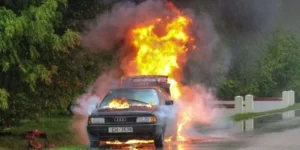First aid for minor or severe burns
When you’re on the road, it’s vital to take all the necessary precautions to avoid accidents. Unfortunately, even with the best will and the greatest care, accidents can sometimes happen. Among the most common injuries in car accidents are burns.
Whether caused by a hot liquid spill or a fire, burns can be particularly painful and cause long-term damage if not treated properly. In this article, we’ll discuss burn first aid procedures for both minor and serious burns, to help drivers and passengers act quickly and effectively in an emergency.
The different types of burns and their severity
Burns are often classified according to their severity.
First-degree burns affect only the top layer of skin, causing redness, pain and a sensation of heat.
Second-degree burns are more serious, damaging the deeper layers of the skin, causing blistering and intense pain.
Third-degree burns are the most serious and affect all layers of the skin, including nerves and blood vessels, resulting in loss of sensation and permanent damage. It is therefore important to understand the severity of the burn to determine the appropriate treatment.
We also have chemical, electrical and thermal burns, which can cause more serious damage than burns caused by fire or boiling water. Know the nature of the burn so you can act quickly and effectively in an emergency.
First aid for burns
As a driver, you should at least know what to do in the event of a burn while driving. Whether you suffer a burn from handling a hot object or coming into contact with a hot surface, it’s important to know how to perform burn first aid to prevent the injury from worsening.
Example of a minor burn: burn caused by contact with a hot object in the car
If you suffer a minor burn while driving, the first thing to do is soothe the pain by applying cold water to the affected area for about 10 to 15 minutes. You can also use a cold compress or an ice pack wrapped in a clean cloth if you have one to hand.
Then gently clean the affected area with mild soap and water to avoid infection. You can also apply a light burn cream or ointment to help relieve pain and promote healing.
Finally, protect the affected area by covering it with a clean dressing or bandage to avoid rubbing and irritation. Don’t forget to change the dressing regularly to prevent infection and promote healing.
Steps to take in the event of a serious burn
Serious burns are more serious injuries that require rapid, professional intervention. In the context of drivers, serious burns can be caused by car accidents involving fire or explosion.
In such a situation, it’s crucial to call for help immediately. While waiting for help to arrive, move the person away from the heat source and remove burnt clothing if possible, taking care not to aggravate the injuries.
Drench the burn with cold water to help relieve pain and reduce tissue damage. However, don’t use ice or cold compresses, as these can aggravate the burn.
At our driving school, we offer comprehensive training for drivers in first aid for serious burns. We also stress the importance of remaining calm and following the instructions of the emergency services until they arrive. By acting quickly and effectively, we can save lives and reduce the serious consequences of these injuries.
How can you avoid burns in everyday life as a driver?
As a vehicle driver, it’s important to take certain precautions to avoid burns in everyday life. First of all, make sure your vehicle is in good working order, especially the cooling system and exhaust pipes. This can help prevent burns caused by leaking coolant or hot exhaust pipes.
In addition, wear appropriate clothing for driving, avoiding synthetic or flammable fabrics. If you’re carrying hot items, such as drinks or ready-made meals, make sure they’re properly packed and stable to avoid spills and burns.
Despite all these precautions, burns can sometimes occur. If the burn is extensive or deep, call emergency services and do not attempt to treat it yourself.
However, in the event of a minor burn, burn first aid can be performed quickly and effectively to relieve pain and prevent infection. These first aid gestures are taught during first aid training, such as that provided by our driving school. We offer first aid courses on weekdays and weekends to enable you to learn burn first aid.
Conclusion
Burns are common accidents that can happen at any time, even when driving a vehicle. That’s why it’s important for drivers to know what to do in the event of a minor or serious burn, and what preventive measures to take to avoid such incidents.
First aid training for burns or in general is offered by our driving school center Auto-école Lémanique Genève helps drivers to be better prepared in case of emergency. Our weekday and weekend burn and general first aid courses are taught by experienced and qualified instructors, who can provide practical advice and demonstrations on how to handle emergency situations.
Ultimately, by taking the right preventive measures and being well-informed about burn first aid, you can drive safely and be ready to act in an emergency.

